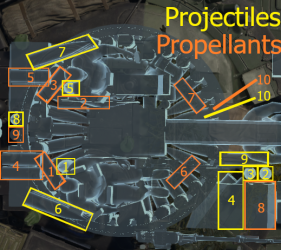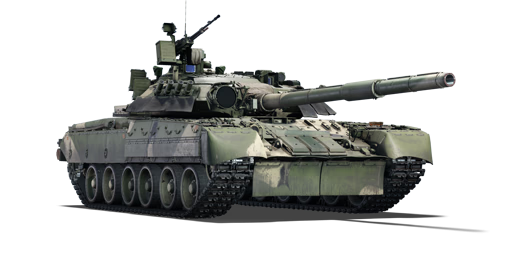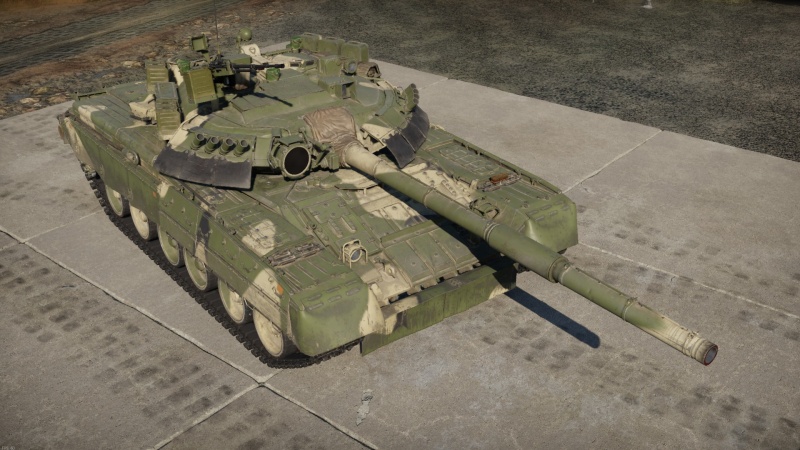Difference between revisions of "T 80 U (Sweden)"
(→Ammunition: Converted to transclusion) |
(→Survivability and armour) |
||
| Line 19: | Line 19: | ||
{{Specs-Tank-Armour}} | {{Specs-Tank-Armour}} | ||
<!-- ''Describe armour protection. Note the most well protected and key weak areas. Appreciate the layout of modules as well as the number and location of crew members. Is the level of armour protection sufficient, is the placement of modules helpful for survival in combat? If necessary use a visual template to indicate the most secure and weak zones of the armour.'' --> | <!-- ''Describe armour protection. Note the most well protected and key weak areas. Appreciate the layout of modules as well as the number and location of crew members. Is the level of armour protection sufficient, is the placement of modules helpful for survival in combat? If necessary use a visual template to indicate the most secure and weak zones of the armour.'' --> | ||
| − | ''Describe armour protection. Note the most well protected and key weak areas. Appreciate the layout of modules as well as the number and location of crew members. Is the level of armour protection sufficient, is the placement of modules helpful for survival in combat? If necessary use a visual template to indicate the most secure and weak zones of the armour.'' | + | ''Describe armour protection. Note the most well protected and key weak areas. Appreciate the layout of modules as well as the number and location of crew members. Is the level of armour protection sufficient, is the placement of modules helpful for survival in combat? If necessary use a visual template to indicate the most secure and weak zones of the armour.'' --> |
| + | The armour protection of the {{PAGENAME}} is adequate, especially if the incoming round hits one of the KONTAKT-5 ERA plates while newer shells such as the DM53 can still frontally penetrate the hull armour at close range. The strongest parts of the tank are the turret front and a majority of the upper front plate. It does, however, have some weaker areas, the most important being the driver's hatch, the immediate areas of the turret surrounding the gun and its breech, and its lower frontal plate. These weak spots are however pretty small targets at range, and thus by hiding them properly, the risk of being hit can be minimized. Owing to its very low profile, a hull-down T-80U is a small target in itself; the weaker parts of its armour are even smaller. | ||
| + | |||
| + | Fuel tanks on either side of the driver cannot soak up some shrapnel as recent changes have added fuel explosions, and these tanks detonate dramatically. As with all Russian auto-loaded MBTs, there are only three crew members so a well-placed shot is capable of causing a crew knock-out. It's also worth noting that the placement of the ammo rack, below the turret in a carousel-style setup, leaves the T-80U particularly vulnerable to side shots causing ammunition detonation. The protection of the T-80U is very similar to the T-64B in terms of the size and placement of the weak areas. The sides of your tank should always be protected, and when engaging an enemy, your front armour should always be aligned directly towards him to reduce the risks of a shot penetrating your weaker side. The tank does, however, have some KONTAKT-5 ERA on its upper front skirts, meaning that you have some extra protection against kinetic penetrators, and a lot against chemical shells, until the ERA bricks are detonated (leaving the area vulnerable for another hit). | ||
| + | |||
| + | As mentioned above, the T-80U also benefits from the typical low silhouette Russian tankers will be accustomed to, with the vehicle being significantly smaller than its competitors. This allows the T-80U to be hidden behind small terrain deformities which other MBTs would otherwise be visible. It's also harder for an enemy tank commander to immediately tell which area is the most vulnerable. But armour cannot be relied on in any circumstance, the tank is no longer new, and weaknesses are well known. Most tankers will have a steady aim at hitting weak spots even on the move. | ||
'''Armour type:''' <!-- The types of armour present on the vehicle and their general locations --> | '''Armour type:''' <!-- The types of armour present on the vehicle and their general locations --> | ||
Revision as of 03:02, 1 February 2023
| This page is about the medium tank T 80 U (Sweden). For other versions, see T-80 (Family). |
Contents
Description
The T 80 U is a squadron rank VIII Swedish medium tank with a battle rating of 11.3 (AB/RB/SB). It was introduced in Update "Fire and Ice".
A contender in Swedish trials for a possible adoption of new tank in the 1990s, the T 80 U is not too dissimilar from the Soviet T-80U. The most significant difference of the T 80 U from the T-80U in the game is the lack of 3BM46 APFSDS round for the cannon. While the T 80 U lacks the most powerful kinetic round, it still has the same armour and mobility performances for players used to the T-80U playstyle to quickly acclimate to.
General info
Survivability and armour
Describe armour protection. Note the most well protected and key weak areas. Appreciate the layout of modules as well as the number and location of crew members. Is the level of armour protection sufficient, is the placement of modules helpful for survival in combat? If necessary use a visual template to indicate the most secure and weak zones of the armour. --> The armour protection of the T 80 U (Sweden) is adequate, especially if the incoming round hits one of the KONTAKT-5 ERA plates while newer shells such as the DM53 can still frontally penetrate the hull armour at close range. The strongest parts of the tank are the turret front and a majority of the upper front plate. It does, however, have some weaker areas, the most important being the driver's hatch, the immediate areas of the turret surrounding the gun and its breech, and its lower frontal plate. These weak spots are however pretty small targets at range, and thus by hiding them properly, the risk of being hit can be minimized. Owing to its very low profile, a hull-down T-80U is a small target in itself; the weaker parts of its armour are even smaller.
Fuel tanks on either side of the driver cannot soak up some shrapnel as recent changes have added fuel explosions, and these tanks detonate dramatically. As with all Russian auto-loaded MBTs, there are only three crew members so a well-placed shot is capable of causing a crew knock-out. It's also worth noting that the placement of the ammo rack, below the turret in a carousel-style setup, leaves the T-80U particularly vulnerable to side shots causing ammunition detonation. The protection of the T-80U is very similar to the T-64B in terms of the size and placement of the weak areas. The sides of your tank should always be protected, and when engaging an enemy, your front armour should always be aligned directly towards him to reduce the risks of a shot penetrating your weaker side. The tank does, however, have some KONTAKT-5 ERA on its upper front skirts, meaning that you have some extra protection against kinetic penetrators, and a lot against chemical shells, until the ERA bricks are detonated (leaving the area vulnerable for another hit).
As mentioned above, the T-80U also benefits from the typical low silhouette Russian tankers will be accustomed to, with the vehicle being significantly smaller than its competitors. This allows the T-80U to be hidden behind small terrain deformities which other MBTs would otherwise be visible. It's also harder for an enemy tank commander to immediately tell which area is the most vulnerable. But armour cannot be relied on in any circumstance, the tank is no longer new, and weaknesses are well known. Most tankers will have a steady aim at hitting weak spots even on the move.
Armour type:
| Armour | Front (Slope angle) | Sides | Rear | Roof |
|---|---|---|---|---|
| Hull | ___ mm | ___ mm Top ___ mm Bottom |
___ mm | ___ - ___ mm |
| Turret | ___ - ___ mm Turret front ___ mm Gun mantlet |
___ - ___ mm | ___ - ___ mm | ___ - ___ mm |
| Cupola | ___ mm | ___ mm | ___ mm | ___ mm |
Notes:
Mobility
| Game Mode | Max Speed (km/h) | Weight (tons) | Engine power (horsepower) | Power-to-weight ratio (hp/ton) | |||
|---|---|---|---|---|---|---|---|
| Forward | Reverse | Stock | Upgraded | Stock | Upgraded | ||
| Arcade | 78 | 13 | 46 | 1,937 | 2,385 | 42.11 | 51.85 |
| Realistic | 70 | 11 | 1,106 | 1,250 | 24.04 | 27.17 | |
Modifications and economy
Armaments
Main armament
| 125 mm 2A46M-1 | Turret rotation speed (°/s) | Reloading rate (seconds) | |||||||||||
|---|---|---|---|---|---|---|---|---|---|---|---|---|---|
| Mode | Capacity | Vertical | Horizontal | Stabilizer | Stock | Upgraded | Full | Expert | Aced | Stock | Full | Expert | Aced |
| Arcade | 45 | -5°/+15° | ±180° | Two-plane | 22.8 | 31.6 | 38.4 | 42.5 | 45.2 | 6.50 | 6.50 | 6.50 | 6.50 |
| Realistic | 14.3 | 16.8 | 20.4 | 22.6 | 24.0 | ||||||||
Ammunition
| Penetration statistics | |||||||
|---|---|---|---|---|---|---|---|
| Ammunition | Type of warhead |
Penetration @ 0° Angle of Attack (mm) | |||||
| 10 m | 100 m | 500 m | 1,000 m | 1,500 m | 2,000 m | ||
| 3BK18M | HEATFS | 550 | 550 | 550 | 550 | 550 | 550 |
| 3OF26 | HE | 42 | 42 | 42 | 42 | 42 | 42 |
| 3BM42 | APFSDS | 457 | 454 | 445 | 431 | 419 | 406 |
| 9M119 | ATGM | 700 | 700 | 700 | 700 | 700 | 700 |
| Shell details | ||||||||||||
|---|---|---|---|---|---|---|---|---|---|---|---|---|
| Ammunition | Type of warhead |
Velocity (m/s) |
Projectile mass (kg) |
Fuse delay (m) |
Fuse sensitivity (mm) |
Explosive mass (TNT equivalent) (kg) |
Ricochet | |||||
| 0% | 50% | 100% | ||||||||||
| 3BK18M | HEATFS | 905 | 19 | 0.05 | 0.1 | 2.79 | 65° | 72° | 77° | |||
| 3OF26 | HE | 850 | 23 | 0.3 | 0.1 | 5.24 | 79° | 80° | 81° | |||
| 3BM42 | APFSDS | 1,700 | 4.85 | - | - | - | 78° | 80° | 81° | |||
| Missile details | ||||||||||||
|---|---|---|---|---|---|---|---|---|---|---|---|---|
| Ammunition | Type of warhead |
Velocity (m/s) |
Range (m) |
Projectile mass (kg) |
Fuse delay (m) |
Fuse sensitivity (mm) |
Explosive mass (TNT equivalent) (kg) |
Ricochet | ||||
| 0% | 50% | 100% | ||||||||||
| 9M119 | ATGM | 445 | 5,000 | 16.5 | 0.05 | 0.1 | 5.72 | 80° | 82° | 90° | ||
Ammo racks

| Full ammo |
Ammo part |
1st rack empty |
2nd rack empty |
3rd rack empty |
4th rack empty |
5th rack empty |
|---|---|---|---|---|---|---|
| 45 | Projectiles Propellants |
45 (+0) 45 (+0) |
44 (+1) 44 (+1) |
43 (+2) 43 (+2) |
38 (+7) 41 (+4) |
37 (+8) 39 (+6) |
| 6th rack empty |
7th rack empty |
8th rack empty |
9th rack empty |
10th rack empty* |
Visual discrepancy |
|
| 34 (+11) 38 (+7) |
31 (+14) 37 (+8) |
30 (+15) 30 (+15) |
29 (+16) 29 (+16) |
1 (+44) 1 (+44) |
No |
Notes:
- The T 80 U (Sweden) uses two-piece ammunition, composed of projectiles (yellow) and propellant bags (orange). Both have separate racks.
- Projectiles and charges are modeled individually and disappear after having been shot or loaded.
- The T 80 U's first stage ammo rack consists of a mechanized carousel at the bottom of the turret which carries 28 propellants and 28 projectiles.
Machine guns
| 12.7 mm NSVT | ||||
|---|---|---|---|---|
| Mount | Capacity (Belt) | Fire rate | Vertical | Horizontal |
| Pintle | 500 (100) | 700 | -5°/+60° | ±180° |
| 7.62 mm PKT | ||||
|---|---|---|---|---|
| Mount | Capacity (Belt) | Fire rate | Vertical | Horizontal |
| Coaxial | 1,250 (250) | 700 | N/A | N/A |
Usage in battles
Describe the tactics of playing in the vehicle, the features of using vehicles in the team and advice on tactics. Refrain from creating a "guide" - do not impose a single point of view but instead give the reader food for thought. Describe the most dangerous enemies and give recommendations on fighting them. If necessary, note the specifics of the game in different modes (AB, RB, SB).
Pros and cons
Pros:
- Ability to use ATGM
- Thermal and laser telemetry
- Effective armour at its BR, protected by ERA blocking explosive munitions or some type of APFSDS.
- Effective acceleration in muddy terrains.
Cons
- Does not have the projectile APFSDS 3BM46 available like the Russians.
- Reverse gear is very slow only 11 km/h
- Very sluggish vertical cannon aiming
- Frontal armour on the underbody of the vehicle does not protect against APFSDS projectiles at all
History
Family page: T-80 Family
At the end of 1993, following the de-scalation after the end of the Cold War, the Swedish army created a programme for the procurement of new MBTs, and held a competition between NATO tanks and after Russia gave 2 T-80U for trial.
The competition featured M1 Abrams from the USA, which had an old 105mm gun, Leclerc from the French and the Leopard 2 from the Germans, but later two T-80Us from Russia were loaned for both combat and technical trials in the 1993/94 semester.
Due to the government's rapid announcement that the Leopard 2 would be acquired and placed at the disposal of mechanised brigades, the trials had to be prematurely discontinued, and the Leopard 2A5 with some Swedish modifications was chosen and entered service as Strv 122.
Media
- Skins
See also
External links
| Sweden medium tanks | |
|---|---|
| Strv m/42 | Lago I · Strv m/42 EH · Ikv 73 · Strv m/42 DT · Pvkv IV |
| Centurion derivatives | Strv 81 · Strv 81 (RB 52) · Strv 101 · Strv 104 · Strv 105 |
| Strv 103 | Strv 103-0 · Strv 103A · Strv 103С |
| Strv 121/122 | Strv 121 · Christian II · Strv 122A · Strv 122B PLSS · Strv 122B+ |
| Other | Sherman III/IV · T 80 U |
| Finland | |
| WWII | ▄T-28 · ▄T-34 · ▄Pz.IV · ▄T-34-85 |
| Post War | ▄Comet I · ▄Charioteer Mk VII · ▄T-54 · ▄T-55M · ▄T-72M1 · ▄Leopard 2A4 · ▄Leopard 2A6 |
| Norway | Leopard 1A5NO2 |
| Squadron ground vehicles | |
|---|---|
| USA | M901 · M1A1 AIM |
| Germany | Leopard 2 PL |
| USSR | BMP-2M · T-80UK |
| Britain | Bhishma TWMP |
| Japan | RCV (P) |
| China | Object 122MT "MC" |
| France | CV 9035NL |
| Sweden | T 80 U |
| Israel | Magach 6B Gal |
- Ground vehicles
- Sweden ground vehicles
- Eighth rank ground vehicles
- Squadron ground vehicles
- Medium tanks
- Ground vehicles with explosive reactive armour
- Ground vehicles with composite armour
- Ground vehicles with smoke grenades
- Ground vehicles with engine smoke generating system
- Ground vehicles with dozer blade
- Ground vehicles with thermal sight
- Ground vehicles with autoloader
- Ground vehicles with gun stabilizer
- ATGM vehicles





